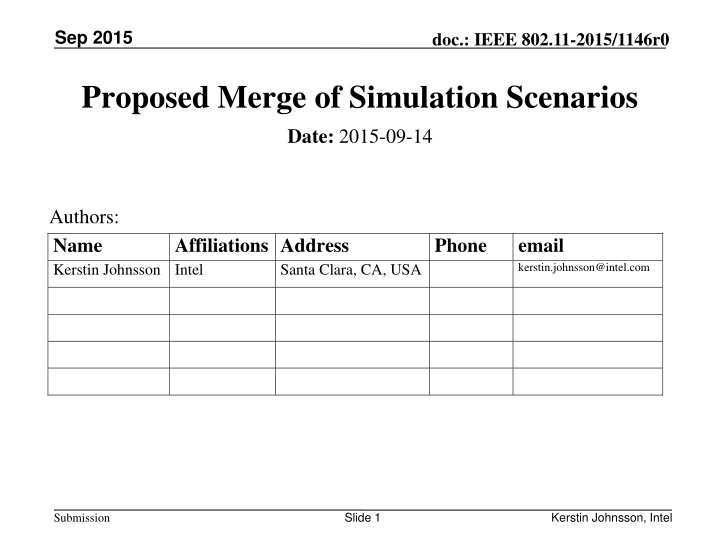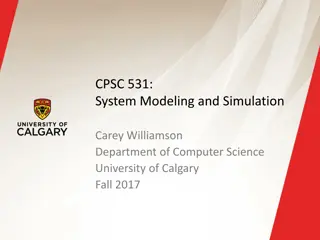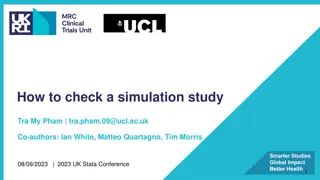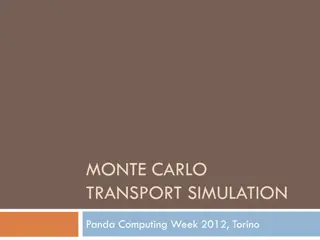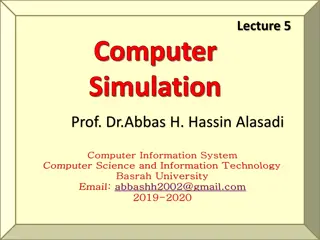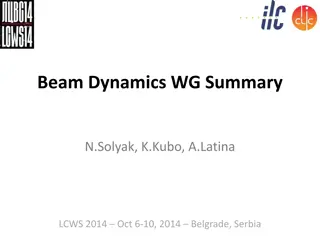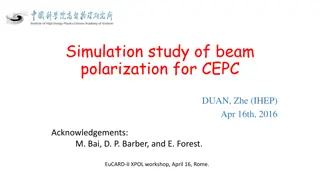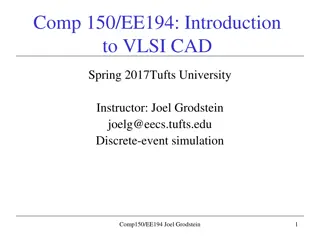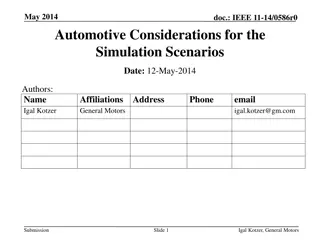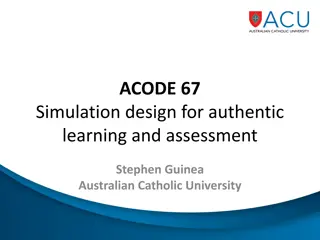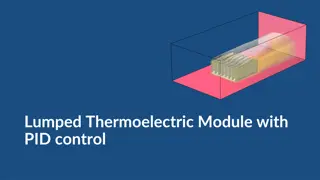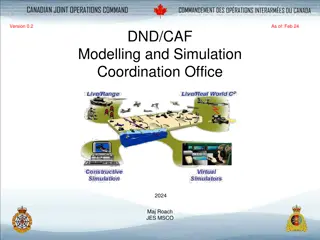Proposed Merge of Simulation Scenarios
This document presents simulation requirements for 11ay usage models and proposes merges for the necessary simulation scenarios. It covers usage models such as Ultra Short Range Communications, 8K UHD Wireless Transfer at Smart Home, and Augmented Reality/Virtual Reality Wearables, detailing their requirements, challenges, advantages, and evaluation methodologies.
Download Presentation

Please find below an Image/Link to download the presentation.
The content on the website is provided AS IS for your information and personal use only. It may not be sold, licensed, or shared on other websites without obtaining consent from the author.If you encounter any issues during the download, it is possible that the publisher has removed the file from their server.
You are allowed to download the files provided on this website for personal or commercial use, subject to the condition that they are used lawfully. All files are the property of their respective owners.
The content on the website is provided AS IS for your information and personal use only. It may not be sold, licensed, or shared on other websites without obtaining consent from the author.
E N D
Presentation Transcript
Sep 2015 doc.: IEEE 802.11-2015/1146r0 Proposed Merge of Simulation Scenarios Date: 2015-09-14 Authors: Name Kerstin Johnsson Intel Affiliations Address Phone email kerstin.johnsson@intel.com Santa Clara, CA, USA Slide 1 Kerstin Johnsson, Intel Submission
Sep 2015 doc.: IEEE 802.11-2015/1146r0 Abstract This document discusses the simulation requirements for 11ay usage models and suggests some potential merges for the required simulation scenarios. Slide 2 Kerstin Johnsson, Intel Submission
Sep 2015 doc.: IEEE 802.11-2015/1146r0 Usage Model 1: Ultra Short Range (USR) Communications Summary: User downloads mass data from a fixed source device to a semi-stationary sink device indoors, at very short range. Requirements: 10 Gbps P2P link < 10 cm Latency < 100 ms Power < 400 mW Advantages: LOS Stationary Low/no interference Evaluation Methodology: LLS Given that the P2P link is LOS, short, and potentially protected, chances are there is little/no interference. Also, since the sink device is stationary, there is no significant change with respect to the environment. When there is not interaction with other users (e.g. interference) or the environment (e.g. blocking), there is no need for an SLS. This usage model can be evaluated using a simple LLS to test data rate, latency, and power. Slide 3 Kerstin Johnsson, Intel Submission
Sep 2015 doc.: IEEE 802.11-2015/1146r0 Usage Model 2: 8K UHD Wireless Transfer at Smart Home Summary: User streams 8K UHD from a fixed source device to a semi-stationary sink device indoors, at moderate range. Requirements: 28 Gbps P2P link < 20 m Latency and jitter < 5 ms Challenges: NLOS Moving (pedestrian speeds) Advantages: Low/no interference Evaluation Methodology: While there is little/no interference from other devices, the sink device could be moving, thus there may be significant interaction with the environment. As a result, this usage model is best evaluated in an SLS. However, the requirements and challenges of this usage model will be met if the requirements and challenges of Usage Model 3 (VR/AR) are met. Thus, it can be subsumed by Usage Model 3. Slide 4 Kerstin Johnsson, Intel Submission
Sep 2015 doc.: IEEE 802.11-2015/1146r0 Usage Model 3: Augmented Reality/Virtual Reality Wearables Summary: AR/VR traffic between a fixed source and slowly moving sink device at moderate range, indoors, with little/no interference; OR between slowly moving source and sink devices at very short range, indoors, in heavy interference conditions. Requirements: 20 Gbps P2P link < 20 m Latency and jitter < 5 ms PER < 10E-2 Challenges: NLOS Moving (pedestrian speeds) Heavy interference Evaluation Methodology: SLS This usage model poses some of the toughest challenges of any in the group. Not only are the source and sink devices potentially moving, there exists the potential for very high interference in some environments (e.g. commuter). Thus, this usage model must be evaluated in an SLS. Slide 5 Kerstin Johnsson, Intel Submission
Sep 2015 doc.: IEEE 802.11-2015/1146r0 Usage Model 4: Data Center 11ay Inter-Rack Connectivity Summary: Mixed traffic between a fixed source device and one or more fixed sink devices, indoors at short range. Requirements: 20 Gbps P2P/P2MP links < 2 m Latency < 100 ms PER < 10E-2 Advantages: LOS Stationary devices Evaluation Methodology: Due to the possibility of multi-hop configuration, this usage model needs an SLS for proper evaluation. However, the requirements and challenges of this usage model will be met if the requirements and challenges of Usage Model 8 (Backhauling) are met. Thus, it can be subsumed by Usage Model 8. Slide 6 Kerstin Johnsson, Intel Submission
Sep 2015 doc.: IEEE 802.11-2015/1146r0 Usage Model 5: Mass Data Distribution/Video on Demand Summary: Mass data distribution between fixed source device and many semi-stationary sink devices, indoors at large range. Requirements: 20 Gbps P2P/P2MP links < 100 m Latency < 100 ms Challenges: NLOS Moving (pedestrian speeds) Potentially heavy competition for channel resources Evaluation Methodology: Due to the mobility of users and heavy competition for channel resources, this usage model must be evaluated in an SLS. However, the requirements and challenges of this usage model will be met if the requirements and challenges of Usage Model 6 (Offloading) are met. Thus, it can be subsumed by Usage Model 6. Slide 7 Kerstin Johnsson, Intel Submission
Sep 2015 doc.: IEEE 802.11-2015/1146r0 Usage Model 6: Mobile Offloading and Multi-Band Operation Summary: Offloading cellular traffic onto 60 GHz APs, indoors and outdoors at large range. Requirements: 20 Gbps P2P/P2MP links < 100 m Latency < 100 ms PER < 10E-2 Challenges: NLOS Moving (pedestrian speeds) Heavy interference Evaluation Methodology: SLS Due to the heavy interference and mobility of users, this usage model requires evaluation via SLS. Slide 8 Kerstin Johnsson, Intel Submission
Sep 2015 doc.: IEEE 802.11-2015/1146r0 Usage Model 7: Mobile Fronthauling Summary: Forwarding mixed traffic from fixed baseband unit to fixed remote radio heads, outdoors at large range. Requirements: 20 Gbps P2P/P2MP links < 200 m Advantages: LOS Stationary devices Low/no interference Evaluation Methodology: Since there is little/no interference and devices are stationary, there is no need to model the environment; an LLS should suffice for the purpose of evaluating range extension. However, the requirements and challenges of this usage model will be met if the requirements and challenges of Usage Model 8 (Backhauling) are met. Thus, it can be subsumed by Usage Model 8. Slide 9 Kerstin Johnsson, Intel Submission
Sep 2015 doc.: IEEE 802.11-2015/1146r0 Usage Model 8: Wireless Backhauling Summary: Forwarding mixed traffic from fixed AP to fixed AP outdoors at large range. Requirements: 20 Gbps P2P/P2MP links < 1000 m Latency < 35 ms Advantages: LOS Stationary devices Low/no interference Challenges: Potential multi-hop Evaluation Methodology: SLS While there is little/no interference and no mobility, this usage model should be modeled in an SLS due to the potential for multi-hop. Slide 10 Kerstin Johnsson, Intel Submission
Sep 2015 doc.: IEEE 802.11-2015/1146r0 Usage Model 9: Docking Station Summary: Sending mixed traffic between fixed docking station and fixed peripherals, indoors at short range. Requirements: 20 Gbps P2P/P2MP links < 2 m Latency < 35 ms Challenges: NLOS Heavy interference Moving (pedestrian speeds) Evaluation Methodology: This usage model requires SLS evaluation given the potential for heavy interference and moving devices. However, the requirements and challenges of this usage model will be met if the requirements and challenges of Usage Model 3 (VR/AR) are met. Thus, it can be subsumed by Usage Model 3. Slide 11 Kerstin Johnsson, Intel Submission
Sep 2015 doc.: IEEE 802.11-2015/1146r0 Potential MAC Simulation Scenarios 1. SLS for AR/VR commuter usage model to evaluate MAC performance (throughput, latency, jitter, PER) in high densities of mobile, NLOS, short range P2P links. This SLS incorporates the MAC challenges and requirements of 8K UHD and Docking Station usage models. 2. SLS for Offloading usage model to evaluate MAC performance (throughput, latency, PER) in high densities of mobile, NLOS, long range P2MP links. This SLS incorporates the MAC challenges and requirements of Mass Distribution usage model. 3. SLS for Backhauling usage model to evaluate MAC performance (throughput, latency) in multi-hop, LOS, very long range P2MP links. This SLS incorporates the MAC challenges and requirements of Data Center and Fronthauling usage models. Slide 12 Kerstin Johnsson, Intel Submission
